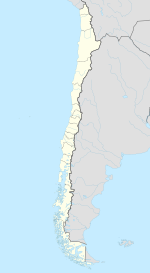Talcahuano
| Talcahuano | |||||
|---|---|---|---|---|---|
| City, Port and Commune | |||||

Talcahuano viewed from Michimalonco
|
|||||
|
|||||
| Coordinates (city): 36°43′0″S 073°07′19″W / 36.71667°S 73.12194°WCoordinates: 36°43′0″S 073°07′19″W / 36.71667°S 73.12194°W | |||||
| Country | Chile | ||||
| Region | Biobío | ||||
| Province | Concepción | ||||
| Founded | 1764 | ||||
| Government | |||||
| • Type | Municipality | ||||
| • Alcalde | Gastón Saavedra Chandía (Ind.) | ||||
| Area | |||||
| • City, Port and Commune | 92.3 km2 (35.6 sq mi) | ||||
| Elevation | 1 m (3 ft) | ||||
| Population (2012 Census) | |||||
| • City, Port and Commune | 150,499 | ||||
| • Density | 1,600/km2 (4,200/sq mi) | ||||
| • Metro | 250,348 | ||||
| • Urban | 248,964 | ||||
| • Rural | 1,384 | ||||
| Demonym(s) | Talcahuian | ||||
| Sex | |||||
| • Men | 121,778 | ||||
| • Women | 128,570 | ||||
| Time zone | CLT (UTC−4) | ||||
| • Summer (DST) | CLST (UTC−3) | ||||
| Area code(s) | 56 + 41 | ||||
| Website | Official website (Spanish) | ||||
Talcahuano (Spanish pronunciation: [talkaˈwano]) is a port city and commune in the Biobío Region of Chile. It is part of the Greater Concepción conurbation. Talcahuano is located in the south of the Central Zone of Chile.
Together with ten other municipalities, it forms part of the Concepción Province, which in turn is one of four provinces that forms the VIII Region of Biobío Region.
According to the 2002 census of the National Statistics Institute, Talcahuano spans an area of 145.8 km2 (56 sq mi) and has 250,348 inhabitants (121,778 men and 128,570 women). Of these, 248,964 (99.4%) lived in urban areas and 1,384 (0.6%) in rural areas. The population grew by 59.9% (93,766 persons) between the 1992 and 2002 censuses. With a population density of 1,873 inhabitants per square kilometre, it is the seventh most populated city of the country.
The official foundation date of Talcahuano is November 5, 1764 when Antonio Guill y Gonzaga declared an official port. However, Talcahuano began to appear in history books as early as 1544 when Genoese captain Juan Bautista Pastene discovered the mouth of the Biobío river while exploring the coast in his ships “San Pedro” and “Santiaguillo”. In 1601 Alonso de Ribera built Fort Talcahueno to defend remaining Spanish settlements near Concepción.
The city is named after an Araucanian chief, Talcahueñu, who inhabited the region at the arrival of the Spanish. In Mapudungun, the language of the indigenous Mapuches, Talcahuano means “Thundering Sky”.
...
Wikipedia



